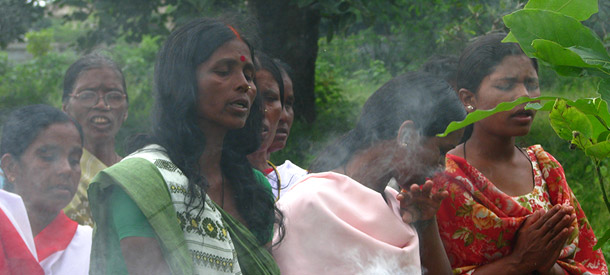पूर्व-मध्य इंडियामध्ये मोठ्या संख्येने पवित्र ग्रोव्हज आहेत. असे मानले जाते की या ग्रोव्हजमध्ये सरना मटा नावाची देवता आहे. स्थानिक विश्वासांनुसार, गेल्या दशकांमध्ये या ग्रॉव्हमध्ये तिने पाहिलेल्या बिघडल्यामुळे सरना मटा दु: खी झाली आहे.. आता, ती स्थानिक मूळ महिलांच्या मनात स्वत: ला व्यक्त करते, ताब्यात घेण्याच्या स्वरूपात. यामुळे संरक्षणाच्या चळवळीस कारणीभूत ठरले आहे, पुनरुज्जीवन आणि पवित्र चरांचे पुन्हा निर्मिती. या ग्रोव्हमध्ये सामान्यत: सालचा क्लस्टर असतो (शोरिया रोबस्टा) झाडे, इतर झाडाच्या प्रजातींच्या काही उदाहरणांसह.
"प्रत्येकजण आकाशाच्या देवाची उपासना करतो, त्यांना पृथ्वीची देवी लक्षात ठेवण्याची गरज आहे" - स्पर्ध: सेल्फ मटा समर्पित.
धमक्या या पवित्र नैसर्गिक साइटवरील धमकी प्रामुख्याने इकोफेमिनिस्ट चळवळीस होणार्या धमक्या आहेत, स्थानिक इकोसिस्टमला थेट धमक्या देण्याऐवजी. या चळवळीचा सर्वात प्रमुख आणि स्पष्ट धोका म्हणजे भारतीय पुरुषप्रधान. स्त्रीलिंगी अधीनतेची अपेक्षा भारतात व्यापक आहे आणि परिणामी इकोफेमिनिस्ट चळवळीकडे काही सामाजिक गटांद्वारे संशयाने पाहिले जाते. पवित्र नैसर्गिक साइट्समध्ये प्रवेश करणार्या पुरुषांवर हल्ला करणार्या पुरुषांची प्रकरणे उद्भवली आहेत. इतर प्रकरणांमध्ये, विधीविना महिलांवर जादूटोणा केल्याचा आरोप आहे.
संरक्षक
सरना मटाची चळवळ ही एक विलक्षण बाब आहे कारण त्याचे मूळ मुख्यत्वे ओरेन जमातीच्या महिलांनी पृथ्वी-आधारित आध्यात्मिक देवता सरना माता यांच्या उपासनेच्या उत्स्फूर्त धार्मिक पुनरुज्जीवनात असल्याचे दिसते.. सरना मटा ही एक सॅन्स्क्रिटिक देशी देवी आहे आणि सर्वोच्च पुरुष देवताची मादी देशभक्त असल्याचे समजते..
पारंपारिक धार्मिक विधींच्या उपासनेमध्ये महिलांचा सहभाग निषिद्ध होता, स्त्रिया आता धार्मिक कार्याचा मुख्य भाग बनवतात. या महिलांच्या मते, हा मूलगामी बदल ताब्यात घेण्यात आला ज्यामध्ये त्यांचा विश्वास आहे. ताब्यात असताना, या स्त्रिया सामाजिक देखावा बिघडल्यामुळे देवीचा राग असल्याचे मानतात त्या स्त्रिया आवाज करतात, वातावरण आणि विशेषतः, तिचे अध्यक्ष होते त्या पवित्र चरांच्या दुर्लक्ष केल्याने तिचा क्रोध. चळवळीच्या सुरुवातीच्या टप्प्यात ज्या स्त्रिया या ताब्यात घेतल्या आहेत अशा स्त्रिया त्यांच्या समुदायांद्वारे विसरल्या गेलेल्या पवित्र नैसर्गिक साइट्सकडे कारणीभूत ठरल्या आहेत.. तिच्या स्वत: च्या चेतनाच्या खोलीत सरना मटाच्या शोधामुळे या महिलांना आणि इतरांना पवित्र ग्रोव्हजच्या पुनर्जन्माचे कारण घेण्यास उर्जा मिळाली आहे - हे असे कार्य आहे ज्यास ते स्वत: ला सर्वात मोठ्या आवेशाने समर्पित करीत आहेत. आजकाल, या चळवळीमध्ये असंख्य सरना मटा गट आहेत, पूर्व-मध्य भारतातील संपूर्ण प्रदेशात पसरला.
दृष्टी
या प्रदेशातील जवळजवळ प्रत्येक गावात असलेल्या पवित्र चरांमध्ये भेटणार्या महिलांच्या गटांना स्वत: ची मदत गट म्हणून ओळखल्या जाणार्या शरीरात स्वत: ला तयार करण्यात रस आहे, राज्य आणि स्वयंसेवी संस्था प्रायोजित. हे मायक्रो-फायनान्सिंग युनिट्स म्हणून कार्य करेल, आणि महिलांना हस्तनिर्मित उत्पादनांच्या उत्पादन आणि विक्रीसह सूक्ष्म-एंटरप्राइझस प्रारंभ करण्यास सक्षम करेल.
युती
सामा माता चळवळीने ग्रोव्ह्जला वेढलेल्या भिंती बांधण्यासाठी सरकारच्या आर्थिक मदतीसाठी यशस्वीरित्या मोहीम राबविली आहे आणि ते मिळविण्यात यशस्वी झाले आहे. एक चळवळ म्हणून, त्यांच्या कम्युनिटीच्या उपासनेला बर्याच पुरुषांनी पाठिंबा दर्शविला आहे - आणि लक्षणीय काही राजकारण्यांनी. या चळवळीने प्रादेशिक राजकीय पक्षालाही वाढवले आहे.
कृती
आज, या स्त्रिया प्रत्येक आठवड्यात पवित्र ग्रोव्हमध्ये धार्मिक सेवा घेताना पाहू शकतात, त्यांच्या स्वत: च्या शोधाच्या विधीसह पूर्ण करा.
ते सालच्या नवीन रोपट्यांची लागवड करतात आणि भक्ती करतात (शोरिया रोबस्टा) आणि करम (नॅकलिया पर्विजोलिया), आणि या रोपट्या विषारी बारमाहीसह वेढून घ्या की त्यांना चरण्यापासून टाळता येईल.
याशिवाय, पवित्र नैसर्गिक साइटच्या संरक्षणासाठी पैसे गोळा करण्यासाठी ते याचिका आयोजित करतात, आणि ते हळूहळू अधिक राजकीयदृष्ट्या गुंतत आहेत.
परिणाम
विद्यमान पवित्र ग्रोव्हमध्ये, कोणालाही झाडे कापण्याची परवानगी नाही, आणि महिलांच्या भक्ती काळजी अंतर्गत नवीन रोपांची भरभराट होत आहे. चळवळीचे बळकटीकरण परिणामी जैवविविधता संवर्धन आणि विद्यमान किंवा दुर्लक्षित पवित्र खोबणीचे वनीकरण होते, त्याद्वारे सरना मटाची शक्ती पुन्हा स्थापित करणे. खरंच, अगदी नवीन पवित्र ग्रोव्ह्स देखील तयार केले गेले आहेत. असे मानले जाते की ते भूतकाळातील पवित्र चर विसरतात, ट्रान्स विधीद्वारे लक्षात ठेवले.
या चळवळीने प्रचंड विवादास्पद परिणामासह नवीन स्त्रीवादी चेतनाला जन्म दिला आहे, ग्रामीण पूर्व-मध्य भारतातील अधिक व्यापक निसर्ग संवर्धनास कारणीभूत ठरले.
- बिरसा संस्कृतिक संग्राकशान समिती ही चळवळीच्या तळागाळातील नेत्यांनी स्थापन केलेली स्वयंसेवी संस्था आहे. हे सामाजिक-आर्थिकदृष्ट्या वचनबद्ध आहे, सरना चळवळीचा मोठ्या आधार असलेल्या उपेक्षित स्वदेशी समुदायांचे पर्यावरणीय आणि सांस्कृतिक सबलीकरण.
- आर. (2010) देवी Ecofeminist योद्धा म्हणून: पूर्व-मध्य भारतातील पवित्र नैसर्गिक साइट भूमिका reclaiming. Verschuuren मध्ये, वन्य, McNeely आणि Oviedo, पवित्र नैसर्गिक साइट्स, निसर्ग व संस्कृती संवर्धन, पृथ्वी स्कॅन, लंडन.




